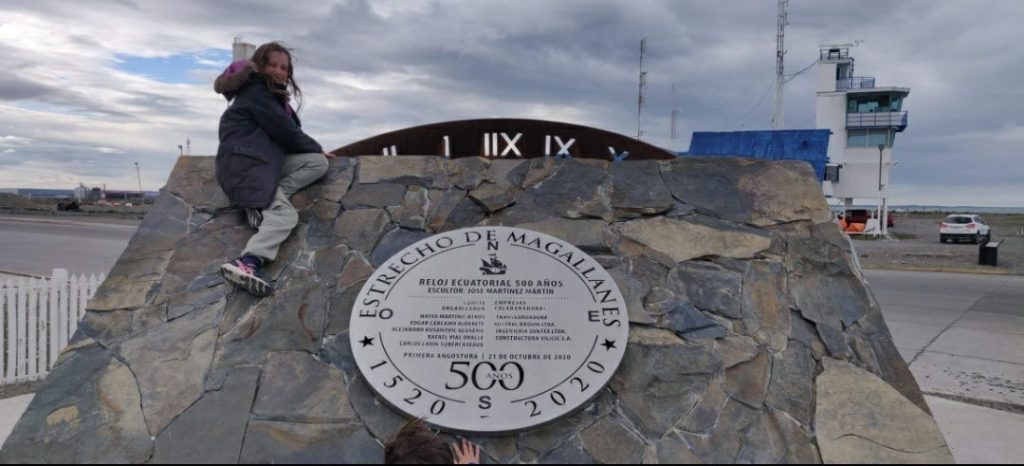Tierra del Fuego, translated as “Land of Fire”, is an archipelago located at the very bottom of South America. It covers an area almost 74,000km squared, or slightly bigger than Czech Republic. It is split between Argentina (1/3) and Chile (2/3), based on a 1881 boundary agreement between the two (not-so-friendly) neighbours. 135,000 people call this land home, with many working in petroleum extraction, tourism and Antarctic logistics. The earliest known settlement here dates back more than 10,000 years ago. The Yaghan people present then somehow managed to eek our an existence as nomadic hunter-gatherers, traveling between islands via home-made canoes.
What the above fails to disclose however is the fearsome wind that dominates and defines this enclave. Oh the wind…
Our Tierra del Fuego adventure started with a relatively non-descript ferry crossing from Punta Delgada to Bahia Azul. Gentle rolling waves were only interrupted by native dolphins playing in the boats waves. We even made it all the way to the southernmost city of Ushuaia with relatively little breeze, enjoying the spectacular views and sense of wilderness along the way. It all seemed a little bit too comfortable, even easy you might say. As we headed north to leave the archipelago, driving the very same road we had a couple of weeks previously, we really had no reason to suspect anything would be different this time. It all seemed very straightforward, you might even say easy, to that point. Soon after however, the local breeze started to introduce itself to us.
So a camper van like ours is essentially a large empty box that moves at a not-insignificant pace. Those of you with an advanced degree in physics, or just a vague understanding of force and movement, will understand that this is not an ideal combination when driving in high winds. Strong cross winds, hitting a proverbial moving target board on the move, creates a force that can be physically difficult to manage.
It all started as we approached the petroleum services town of Cerro Sombrero in Chile. Beginning as a gentle pull on the steering wheel, the wind gradually increased until my arms were aching from the strain of keeping the vehicle traveling straight. Every so often, we would be rocked by the thunderous boom of a double-decker tourist bus passing us in the other direction. The effect of said-busses was not just auditory however. As they passed, their trailing wind fused with the prevailing cross-wind to first push us in the direction of the grass verge, then suddenly pull us violently back across our lane towards the oncoming traffic. To say this was a novelty would be unjust to all things new, and certainly was not something they covered in my driving test more than 20 years previously.
Parking up in Cerro Sombrero was like a game of cat-and-mouse between ourselves, the local buildings and the wind. We tested the van in various spots to assess where would be the most wind-protected, and thus least-impactful, for our night. Nights in campervans during high winds can be equally as uncomfortable as the driving challenges. The empty-box theme continues as the wind can rock, shake and howl through all four corners of the vehicle. Having said this, our diligent research worked a treat as the local visitor centre provided more than adequate protection from Tierra del Fuego’s elements.
We rose the next morning for our last 40km to the ferry which would take us back to mainland South America. Winds were still high, but we were hopeful that our travel arrangements would be unaffected. Filling up at the local service station, we were equally optimistic and amazed when the attendant stated that the ferry was rarely delayed or cancelled due to wind. He then estimated the wind at 80km/ph, but told us not to worry as it can often reach double that on a “proper” windy day. Touché indeed…
Not long after leaving the protection of the town, a couple of rattles began on the roof of the campervan. We didn’t have to wait long to realize what they were. Our daughter quickly informed us that she could see the sky appearing from the ceiling as our two vents started to lift upwards in the wind. Thankfully, the vent hinges were still strong enough to fight-off the force of the wind, but only just. As we continued, the natural light visible from the rear seats was getting bigger and bigger. Intervention was needed, and fast. So we pulled in to a lay-by and dealt with the issue in the most advanced and technical way we knew how. Duct tape, and a lot of it, invaded the airspace all around the vents. Not pretty but certainly a solution to a problem.
Click here to read the “High Winds & A Friendly Truck Driver (Part 2 of 2)” blog post






Leave a Reply